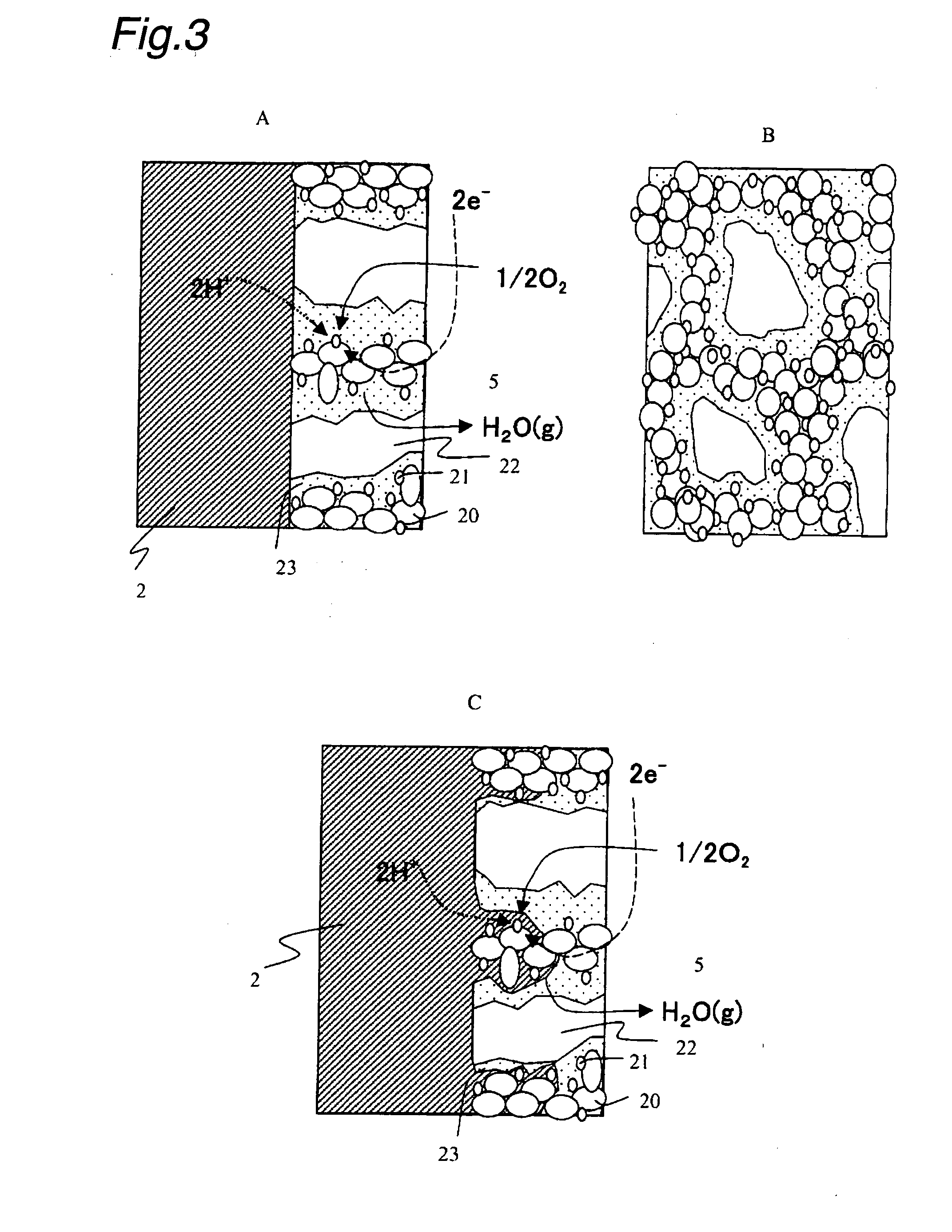Anode for Bioelectric Power Generation And Power Generation Method And Apparatus Utilizing Same
a bioelectric power generation and anode technology, applied in the field of bioelectric power generation, can solve the problems of low energy efficiency and complex apparatus, the diffusion rate of dissolved oxygen in water has a high possibility of becoming a rate limiting step of the entire reaction, and the diffusion rate of dissolved oxygen is found to be a limiting factor, etc., to achieve the effect of simple method, simple apparatus and efficient biological power generation
- Summary
- Abstract
- Description
- Claims
- Application Information
AI Technical Summary
Benefits of technology
Problems solved by technology
Method used
Image
Examples
example 2
[0174]In Example 2, an anode (2) installed in the biological power generation apparatus was prepared by the method described below. Polyethyleneimine was dissolved in water to a concentration of 10 g / L to prepare a hydrophilic polymer solution. A graphite felt as an electroconductive base material was immersed in the hydrophilic polymer solution, which was shaken for 30 seconds. Then, the graphite felt was withdrawn and, after the excess hydrophilic polymer solution was removed, the graphite felt was dried for 24 hours at 100° C. to form a hydrophilic polymer layer. An increase in the weight of the graphite felt by this operation was measured, and the thickness of the hydrophilic polymer layer was calculated from the surface area of the felt measured with a specific surface area meter, and the specific gravity 1.2 of the solidified polymer. This thickness was estimated at an average of 23 nm.
[0175]The so obtained hydrophilic polymer-coated felt (electroconductive base material) was ...
example 3
[0178]In Example 3, an anode (3) installed in the biological power generation apparatus was prepared by the method described below. Polyethyleneimine was dissolved in water to a concentration of 10 g / L to prepare a hydrophilic polymer solution. A graphite felt as an electroconductive base material was immersed in the hydrophilic polymer solution and, with gentle stirring, ethyl(3-dimethylaminopropyl)carbodiimide hydrochloride was added. The reaction was performed for 72 hours to form an amide bond between the graphite and polyethyleneimine. Then, the graphite felt was taken out from the solution, and after the excess hydrophilic polymer solution was removed, the graphite felt was dried for 24 hours at 100° C. to form a hydrophilic polymer layer. The product was washed with 0.1 mol / L of a sodium hydroxide solution, and then the procedure mentioned below was performed. The thickness of the hydrophilic polymer layer was estimated at an average of 21 nm.
[0179]The thus obtained hydrophil...
example 4
[0182]In Example 4, an anode (4) installed in the biological power generation apparatus was prepared by the method described below. Polyethyleneimine was dissolved in water to a concentration of 10 g / L to prepare a hydrophilic polymer solution. A graphite felt as an electroconductive base material was immersed in the hydrophilic polymer solution under the same conditions as in Example 2. The graphite felt was withdrawn and, after the excess hydrophilic polymer solution was removed, the graphite felt was dried for 24 hours at 100° C. to form a hydrophilic polymer layer. The thickness of the hydrophilic polymer layer was estimated at an average of 23 nm.
[0183]The thus obtained hydrophilic polymer-coated felt (electroconductive base material) was immersed in tetrahydrofuran, and the aforementioned AQS chloride was added in an amount equimolar with the constituent hydrophilic monomer units of the hydrophilic polymer. A sulfonamide bond was formed under the same conditions as in Example ...
PUM
| Property | Measurement | Unit |
|---|---|---|
| thickness | aaaaa | aaaaa |
| concentration | aaaaa | aaaaa |
| pH | aaaaa | aaaaa |
Abstract
Description
Claims
Application Information
 Login to View More
Login to View More - R&D
- Intellectual Property
- Life Sciences
- Materials
- Tech Scout
- Unparalleled Data Quality
- Higher Quality Content
- 60% Fewer Hallucinations
Browse by: Latest US Patents, China's latest patents, Technical Efficacy Thesaurus, Application Domain, Technology Topic, Popular Technical Reports.
© 2025 PatSnap. All rights reserved.Legal|Privacy policy|Modern Slavery Act Transparency Statement|Sitemap|About US| Contact US: help@patsnap.com



